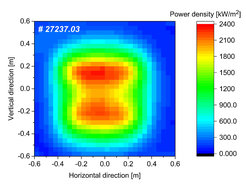IPP’s ELISE test rig achieves first ITER objective
Neutral-particle heating for ITER / Fast-hydrogen-particle beam for plasma heating
The heating beam in the ELISE test rig at Max Planck Institute for Plasma Physics (IPP) at Garching near Munich has attained the values needed for ITER: It can maintain for 1,000 seconds a particle beam composed of negatively charged hydrogen ions with the current strength of 23 amperes desired by ITER.
ELISE is serving to prepare one of the heating methods that are to bring the plasma of the international ITER test reactor to several million degrees. The core piece is a novel high-frequency ion source developed at IPP that produces the high-energy particle beam.

The international ITER (Latin for ‘the way’) test reactor, now being built in France as a world-wide cooperation, is to demonstrate that a fusion fire supplying energy is possible. Like the sun, a future fusion power plant is to derive energy from fusion of atomic nuclei. The fuel, viz. a hydrogen plasma, has to be confined without wall contact in a magnetic field cage and be heated to ignition temperatures exceeding 100 million degrees. ITER is to produce 500 megawatts of fusion power, this being ten times as much as needed beforehand to heat the plasma.
About half of this plasma heating will be provided by the neutral-particle heating: Fast hydrogen atoms injected through the magnetic field cage into the plasma transfer their energy to the plasma particles by way of collisions. For this purpose, an ion source produces from hydrogen gas charged hydrogen ions that are accelerated by high voltage and finally re-neutralised so that, as fast hydrogen atoms, they can penetrate into the plasma unhampered by the magnetic field.
This method enables present-day heating systems, e.g. that for IPP’s ASDEX Upgrade fusion device at Garching, to bring the plasma to a multiple of the sun’s temperature at the click of a button. The ITER large-scale device, however, presents higher requirements: For example, the particle beams have to be much thicker and the individual particles be much faster than hitherto so that they can penetrate the voluminous ITER plasma to a sufficient depth. Two particle beams with cross-sections about the size of an ordinary door are to feed 16.5 megawatts of heating power into the ITER plasma. ITER will thus greatly surpass the particle beams used in today’s fusion devices, which make do with cross-sections about the size of a dinner plate and much lower velocity.

Therefore, instead of the positively charged ions used hitherto, which cannot be effectively neutralised at high energies, for ITER it is necessary to use negatively charged ions, which are extremely fragile. A high-frequency ion source developed for the purpose at IPP was incorporated in the ITER design. At the end of 2012 IPP was given a contract for further development and adaptions to ITER requirements.
The ELISE (Extraction from a Large Ion Source Experiment) test rig constitutes a source half as large as that for ITER later. ELISE generates an ion beam with a cross-sectional area of about a square metre. The increased format made it necessary to revise the previous technical solutions for the heating method (see PI 2/2015). ELISE has advanced step by step to new orders of magnitude. “Now we are able to produce the desired 23-ampere particle beam of negatively charged hydrogen ions, stable, homogeneous and lasting 1,000 seconds”, states Professor Dr Ursel Fantz, head of IPP’s ITER Technology and Diagnostics division. “The gas pressure in the source and the quantity of electrons retained also meet ITER’s requirements”. It was only the current density of the ion beam that was not quite attained, this being due to the limited power capability of the high-voltage supply available.
Where does it go from here?
Now that ELISE has attained the ion current required by ITER with ordinary hydrogen it is time to tackle the second part of the task and produce ion beams from deuterium, the heavy isotope of hydrogen, albeit not just for 1,000 seconds, but for a whole hour. The system in the original size will be investigated by Italy’s fusion institute, ENEA, in Padua, who will collaborate with IPP. The SPIDER (Source for Production of Ions of Deuterium Extracted from Radio-frequency Plasma) test device was commissioned at Padua in early June. The target data: one-hour pulses with full ITER beam cross-section and 6 megawatts of power in hydrogen and deuterium.
Isabella Milch

